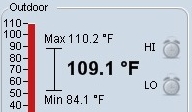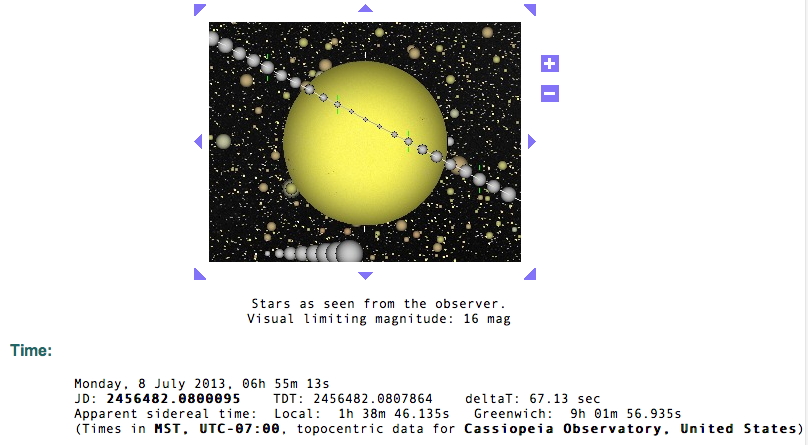
Weather Notes, ISS-Sun Transit
Posted: 8 July 2013
First, some weather notes on why I have not been able to do any observing for a long period of time.
The cloudy skies that began with the rising moon during my last observing session on Wednesday night, 26 June 2013, continued affecting Cassiopeia Observatory for the next several days and nights. There was also smoke from the Silver Fire burning in New Mexico reaching our skies in southern Arizona on Thursday, 27 June.
 Besides clouds, there were also some "warm" days here at 4380' elevation. The image at the right is from the Cassiopeia Observatory weather station at 1405 MST on Friday, 28 June 2013. The 7Timer! forecast for Friday, Saturday, and Sunday afternoons showed a forecast temperature of 108°F, 108°F, and 106°F at Cassiopeia Observatory.
Besides clouds, there were also some "warm" days here at 4380' elevation. The image at the right is from the Cassiopeia Observatory weather station at 1405 MST on Friday, 28 June 2013. The 7Timer! forecast for Friday, Saturday, and Sunday afternoons showed a forecast temperature of 108°F, 108°F, and 106°F at Cassiopeia Observatory.

By 0915 MST, Saturday, 29 June, the temperature had already hit 100°F here. That didn't stop us from removing another pack rat nest from near the observatory. Due to the heat we only got part of the nest removed before we were done in, but the nest was unusable. We reached a max of 108°F Saturday afternoon under cloudy skies.
The sky seemed to be to trying clear up early Sunday morning, 30 June, but it remained very hazy. Tucson set a new record this day; the first June ever of triple  digit temperatures every day. Glad we live in Oracle, where it is (usually) about 10° cooler than Tucson. Began seeing Monsoon cumulus clouds mid-day, as the temperature maxed out at 110°F here (as seen at the left from 1330 MST). Even had a few brief sprinkles of rain Sunday night, with one loud clap of thunder. Monsoon Season is getting in gear and so will I probably have less observing opportunities for the next couple of months. But I had a nice run of observing for about six weeks in May and June.
digit temperatures every day. Glad we live in Oracle, where it is (usually) about 10° cooler than Tucson. Began seeing Monsoon cumulus clouds mid-day, as the temperature maxed out at 110°F here (as seen at the left from 1330 MST). Even had a few brief sprinkles of rain Sunday night, with one loud clap of thunder. Monsoon Season is getting in gear and so will I probably have less observing opportunities for the next couple of months. But I had a nice run of observing for about six weeks in May and June.
Monday, 1 July, dawned partly cloudy, with hazy skies. And the heat continued; hit 100°F here at 1030 MST, with another daytime high of 110°. Skies became overcast with monsoon thunderstorms in the area beginning late in the afternoon. Heard thunder but no rain here. Heavy rain finally arrived Tuesday morning at 0315 MST. Picked up 0.34" of much needed rain in about 30 minutes. After sunrise, I checked the observatory since this was the first rain and wind storm in several months. No problems! The almost four year old POD is still doing great. Things were a little cooler during the day on Tuesday; it wasn't until 1325 MST that we briefly touched 100°F. Tuesday night had a brief monsoon storm go by, but it had only wind (gusts to 34 MPH) and cloud-to-cloud lightning (no thunder heard). No rain. Wednesday was partly cloudy, with a mostly clear forecast for that night. Temp broke 100°F again during the day. The sky became overcast as sunset approached.
Thursday, 4 July, dawned hazy but mostly clear. Reached 100° mid-afternoon. And as happened the day before, cloud cover began increasing as the afternoon progressed, and it continued into the night. Friday dawned overcast and due to the clouds, the temperature did not reach 100°F. Did get some brief sprinkles here (but Tucson got hammered by a monsoon storm with flash floods and winds over 70 MPH).
Saturday, 6 July, dawned with cloudy skies. As the morning progressed, the skies began clearing and the 7Timer! forecast for the night was for clear skies:

Mid-morning we removed another pack rat nest near the observatory. We got a surprise when the occupent came out during the demolition. He looked at us for a couple of minutes before deciding to leave the area. Mid-day, monsoon weather pattern cumulus clouds began popping up and we reached 100°F again. About 1320 MST, I noticed that the Kitt Peak web cams were showing a lot of rain falling there. I looked outside and saw a nice monsoon storm over Kitt Peak, 65 miles away. I took this photograph:

Storm clouds, along with frequent thunder, began here about 1630 MST, decreasing the probability that I would be opening the observatory that night. And as seen from these sunset photos, definitely no observing Saturday night:


Storms to the west Saturday night produced a lot of almost continuous lightning flashes. Unfortunately, from my location about 40 miles away, most of the lightning was behind dense clouds, so I didn't do any lightning photography.
Sunday, 7 July, dawned partly cloudy. The forecast for Sunday night and Monday morning were not good. I was especially concerned about Monday morning's forecast. On Tuesday, 2 July, I received an alert from CalSky.com about an ISS-Sun transit Monday, 8 July 2013, at 0655 MST:

The sun would be only 17° altitude at transit time and so would be very low. In fact, it would be very close to the measured altitude limit (free of obstructions) for that azimuth as seen from the observatory. And the line-of-sight distance to the ISS would be long, making the space station appear small in the telescope. Not an ideal transit.
The sun was visible through clouds Saturday morning, 6 July, and I was able to confirm that the sun would become visible from the observatory about 30 minutes prior to the transit. Sunday morning, since the sun was visible as it cleared the hill to the east, I decided to check the observing conditions from the observatory. Before going out to the observatory at 0650 MST, I checked the CalSky.com web site and discovered that the transit time had shifted by 10 seconds and the path was further north on the sun's disk:

From the observatory, I confirmed that the sun would be close to a tree branch at transit time but above it. So, if the weather cooperated, I would be able to photograph the Sun during the ISS-Sun transit. My previous ISS-Sun transit on 31 December 2012 was clouded out.
The temperature opped 104°F before noon on Sunday, with a max of 108°. A noisy but mostly dry monsoon thunderstorm passed through late in the afternoon. Thanks to a weather spotter friend on Twitter (@AZweatherchick), earlier this day I purchased the RadarScope app. It came in handy as today's storm passed through, as seen on my iPad:

The app displays the raw radar data from the National Weather Service and shows it unsmoothed (unlike the free weather apps). Plus there are many nice features in the app like showing cell tracks and distance measuring. Well worth the price of $10.
While the skies have been cloudy I have taken some time to watch the Carl Sagan Cosmos TV series. I recently purchased the DVD set and have been thoroughly enjoying the shows. The last time I saw the shows was when they were originally on TV in 1980.
Sunday night, 7 July, was cloudy. Due to the cloudy skies over the past many nights I am getting way behind in my observing and imaging plans. Cloudy skies are forecast to continue for the next several nights and now that the moon has started waxing, opportunities are getting limited to accomplish my plans before the moon becomes a problem. Ah, such is the life of an astronomer (on Earth).
So, what about the ISS-Sun transit Monday morning, 8 July? The sky dawned with cloudy skies (of course). The satellite (IR) image wasn't encouraging:

With the slim prospects for clear skies (or even a small hole in the clouds) at the time of the ISS-Sun transit, I didn't even open the observatory to begin preparing for the transit. This is how the sun appeared at 0656 MST:

Oh well, maybe the sky will be clear for the next ISS-Sun transit, whenever that is.
Comments are welcome; use the Comments section below, or you can Email Me. Thanks.
Cassiopeia Observatory Home Page